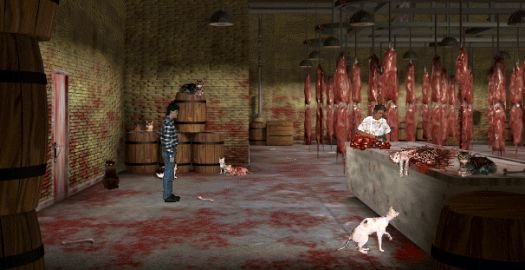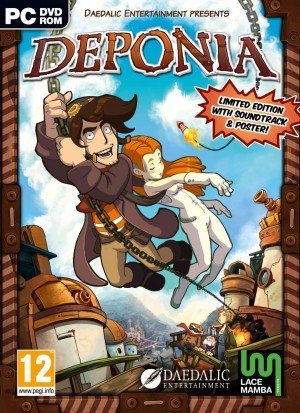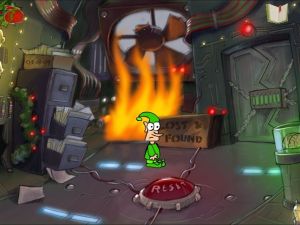Harvester flashback review

Originally released in 1996, Harvester is a point-and-click adventure game that still has the reputation of being one of the most violent adventure games of all time. Its cult popularity has grown over the years, and now that it's been digitally re-released, the game is beginning to find a completely new audience. Its reputation is certainly earned, as Harvester is gory, eccentric, and filled with grotesque violence and downright bizarre characters – all of which the game seems very aware of. What it doesn’t seem to be so aware of are its awful combat mechanics, unresponsive controls, and useless acts of choice that serve no purpose. It’s ambitious in scope and ideas, with a story so mysterious you can’t help but to want to find out more, as well as logical puzzles that can be approached in more ways than one. But it struggles to create a balance between all its ambitions in order to deliver a consistently positive adventure experience.
You play as Steve, an 18-year-old who wakes up one morning to find that he is suffering from amnesia. He soon learns that the year is 1953 and he is in the town of Harvest, a small, “perfect” suburban town – or so it seems. Almost immediately, it’s clear that things are not right here. What’s worse, you’re apparently engaged to a girl named Stephanie Pottsdam, but the southern-speaking (for whatever reason) Stephanie is also suffering from amnesia.
Everyone in Harvest is fixated on ‘The Lodge’, a giant, extravagant building that purportedly holds “true knowledge.” The residents all insist that Steve join the Lodge, as it is the greatest honor for a man to be accepted there. As Steve explores the town, however, he uncovers dark secrets and corruption amongst the townspeople. Convinced that something is askew, Steve decides the only way to discover the truth of what is happening to him and Stephanie is to join the Lodge and become a part of the ‘order of the harvest moon.’
Right from the start, the entire town of Harvest is open for you to explore. Each time you leave a location, an overhead view of the town appears. With 19 locations to investigate right away, I felt overwhelmed as to where to go first, but the town is set up in a very intuitive square surrounding the Lodge as a centerpiece.
Every single person in Harvest is interesting, odd, and unsettling. You’ll meet your brother Hank, who is watching a despicably violent TV show about a cowboy shooting an Indian, whose intestines explode from his stomach as he falls to his death. You’re given a choice to comment on how violent the show is and whether or not a young boy should be watching it, to which Hank responds with a psychopathic but insightful, “This is a part of history. This country was founded on violence.” Then there’s Stephanie’s father, who has an unreasonable obsession with red meat. Most characters have an apparent perversion as well, which at times made me severely uncomfortable. Harvester even goes so far as to touch on child molestation, which I admit shocked me at first, though later I found it fascinating. I have never played a game that’s so deliberately disturbing, and in a strange way it made me more intent on playing the game to the end. Its character extremes make it captivating.
The dialogue trees are massive. Every character has an extensive view or opinion on the subject you ask them about, but sometimes the conversation goes absolutely nowhere, lending nothing to your progress. You periodically have an option about what to say in reply to a question, giving you a sense of choice, but if you talk to that character again, you can repeat the entire conversation and choose a different dialogue path, giving the choice no real consequence at all.
The point-and-click interface is minimal, leaving the screen free of clutter. By clicking on Steve or pressing the ‘I’ key you can view your inventory, which takes up a majority of the screen, showing all your items as well as the day of the week and the status of Steve’s health. The latter is displayed using a photo of his face. As you take more damage, Steve’s face goes from happy to sickened, to bruised, to bloody and swollen. The inventory is huge, and the items are extremely small, which sometimes made it difficult to immediately pinpoint what I was looking for.
You'll collect a massive number of items, but I ended up using only half of them in my playthrough. For example, I collected tampons from a medicine cabinet in Stephanie's bathroom, but at no point found a reason to use them. I also acquired vitamins, painkillers, and other medicine that could be used to restore health, which I never used. And then after entering the Lodge, all my items were taken away from me anyway.
Movement seems almost useless at first, since you can click on hotspots and observe anything from anywhere you stand, even talking to a character on the complete opposite side of the screen. Where you can actually point-and-click Steve to go is very limited. You do have the ability to move with the arrow keys, which allows a little more freedom to wander around the environment, though at times I found myself getting Steve stuck in corners or even on an invisible barrier. Eventually I stopped using the keyboard to move altogether – that is, until combat was introduced.
Combat is easily the number one reason why I’m reluctant to recommend Harvester. For a game that advertised itself as a combination of roleplaying, adventure, and combat game, it falls flat in delivering a balance of the three. My first enemy encounter was with a monster-like dog (which appeared with no explanation for its existence), but you’ll primarily be forced to fight other humans. There are two control methods to fight, neither one being a conventional option. Steve has the ability to attack high, middle, or low, which you do by aiming the cursor and right-clicking. Though this mechanic sounds simple, aiming can be extremely sensitive. Sometimes I’d point the aiming reticle directly in front of Steve, and he’d perform a high attack instead of middle. At other times, when armed with a gun I’d accidently shoot up in the air or at the floor, wasting my already scarce ammunition. The other option is to hold Control and press the arrow key corresponding to the direction you want to attack. I found using the keyboard to attack made things more complicated, however, given that you also use the arrow keys to move. I had trouble coordinating moving and attacking, as I would end up still holding the Control key when I was actually trying to run away. It would have made much more sense to assign three separate keys on the keyboard for high, middle, and low attacks.
Though the game offers this attack mechanic from the start, at first it doesn’t encourage combat as an outlet, and I saw it only as an absolute last resort when I was stuck. When I did first use aggression, after punching a character and tearing their whole torso open with their insides pouring everywhere, I left the screen and immediately got arrested, quickly followed by the electric chair. This obviously reinforced the notion that violence was something I shouldn’t use to resolve issues, but when you reach the last third of the game, it relies on nothing but combat and a very little puzzle-solving. You can die in a fight, resulting in a game over, at which point you’ll have to reload from your last save file since there are no checkpoints or autosaves. Most of the deaths I experienced were solely based on my inability to execute the desired attacks because of the controls.
The game follows through a whole week, Monday to Friday. As you perform specific actions, the setting will turn from night to day (and vice versa), allowing you to explore the town differently. Certain events only occur at night on a specific day, and if not explored thoroughly enough, many things can be missed, though nothing crucial to completing the game. This open world and day/night cycle made Harvester ambitious for its time, as neither was common in 1994 (and still isn’t in most adventure games).
The change of day and night plays an important role in the majority of puzzles, but I found these obstacles repetitive and lacking in thoughtful design. In order to join the Lodge, you’ll have to go through an initiation. This requires you to steal certain items of importance to people or vandalize something, which can be done only at night. But breaking into places requires some of the same items, and after the third time using the same things for the same tasks, it stops feeling satisfying.
The puzzles are generally logical and tend to rely mainly on common sense. Most involve fetch quests, like getting an adult magazine for a dirty old man to distract him. They are primarily inventory-based, but sometimes can be handled in different ways. For example, early in the game you acquire information about a character blackmailing someone in town. You can choose to reveal that you know this information to both characters, or even everyone in town. If you make copies of the information, you can actually blackmail another character to gain personal benefit in more ways than one. But in the midst of mostly intuitive puzzles, some seem a matter of trying every item in inventory on random objects in the environment. Though the game does encourage you to use items in illogical ways from the start, it isn’t fun being forced to aimlessly use them on things you think have no purpose – especially when there are two dozen locations open.
Having so many places to go at once also makes it difficult to keep track of the task at hand. I did not find most of the puzzles to be that challenging, but more often I found myself lost for what to do next. Since a number of puzzles must be solved at night, and since night can only be triggered by a specific event, there were a couple occasions where I found myself aimlessly wandering around town, looking for a way to trigger nightfall. Fortunately, while there is no formal hint system, the people of Harvest will always give you a clue about what to do. Everything you do has an effect on the townspeople, and they all have something to say about it.
The whole game has a strong underlying message about violence in video games. Whether asking the teacher over at Gein Memorial School how she handles corporal punishment or witnessing something extremely disturbing happening to Steve’s baby sister, the game makes a point of showing how violent it can be. All the while, characters mention that violence in media makes people more violent, making Harvester’s satire fairly obvious. The ESRB was created in 1994, which is when the game was initially being developed, so it makes sense that Harvester is as extreme as it is. Writer/director Gilbert P. Austin clearly chose to use gratuitous brutality to protest how violence in video games was being perceived. Those criticizing it from the outside wouldn’t know that, which is another reason why I can’t help but feel an immense appreciation for the game, as well as finding it so fascinating.
Harvester has a haunting atmosphere throughout. Each scene is a pre-rendered environment, and actors were filmed live before being added to the background, similar to games like The 7th Guest. The pixelated characters don't complement the backgrounds, however, as the animations are choppy and sometimes just not pleasant to look at. This gives the game an innately unnatural feel, which adds to Harvester’s already bizarre tone. Unfortunately, the graphics are at times very flat and boring to look at. Most of the homes in Harvest have nothing interesting to them at first glance. This could have been intentional, since clichéd suburban homes are naturally boring, but it doesn’t make for a fun experience to look around. I also found that there were sometimes an unnecessary number of screens to pass through just to get to somewhere interesting. It wasn’t until I entered the Lodge that I discovered the best environments, ranging from a birthday party clown massacre, to a floor made entirely out of human flesh and walls made of giant eyeballs. The Lodge is truly an inspired, creative part of the game… just not enjoyable to play through due to being entirely combat-based.
The soundtrack is quite diverse and at times theatrical. It ranges from ‘50s doo-wop mixed with a sci-fi theremin to elaborate percussion and big ensembles of strings and piano. Despite the forced, over-dramatized acting of the filmed characters, the actual voice work I found pretty impressive, with each person having a distinct personality and tone. The voices really are what define how eccentric and strange these characters are. At times some of the actors speak too slowly or have unnecessarily long pauses between sentences, which made me impatient. But I guess that’s better than actors blasting through their lines. There are subtitles, and you can click to skip through dialogues.
When all was said and done, Harvester took me roughly 7-10 hours to complete, though mileage will surely vary depending on the amount of combat difficulty you experience and aimless wandering around you do. There are two endings to the game, which are affected only by a single choice prior to the conclusion. After choosing one ending, I was able to simply reload my last save file to see the other. Without saying too much, the ending sheds light on why Harvest is the way it is, and it is genuinely satisfying. And it just wouldn’t be Harvester unless it was disturbing as well.
It’s clear that Harvester was aiming to push all boundaries, both by combining its self-proclaimed “arcade action” with a point-and-click horror adventure, and by challenging the censorship of violence in media. There is so much to admire and respect from the game. But can I recommend it? That’s a complicated question. It’s strange, unusual, and unlike anything else you’ve likely ever played. Yet it’s by no means for everyone. It’s perfect for those intrigued by games that are daring or just flat-out bizarre. I think people who love B horror films or the surreal quirkiness of shows like Twin Peaks would also find this game appealing. But due to its sometimes vague objectives, too many characters with too few conversations having anything to do with the progression of the story, and an unbearable fighting system that only gets more prominent as the game goes along, Harvester is not recommended to anyone looking for a smooth-sailing adventure experience.



























